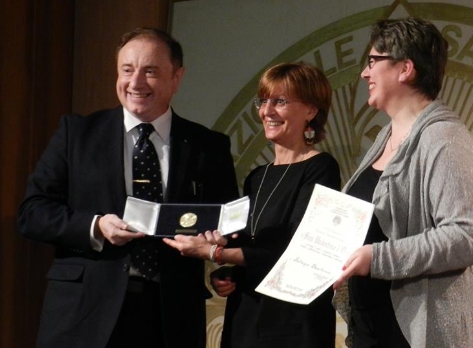The annual prize was founded in 1969 by Agostino Pensa and is meant to recognize the professional devotion of scientist and artists to their work. In the past years the prize has gone, among others, to several distinguished physicists: Ugo Amaldi, Carlo Rubbia, Emilio Segre', Tullio Regge.

Tamburini (left in the above picture at the prize giving in Terni), who until a few years ago was a practically unknown researcher with no permanent position and allegedly scarce prospects of a career in academia, is the mastermind of a groundbreaking discovery which is going to revolutionize the world of electromagnetic transmissions. He is a striking example of how Italy is incapable of recognizing the talent of its scientists. Now he does not need the support of Academia any longer: he is receiving offers from the major companies in the world, eager to exploit his patented techniques. Below is a token of appreciation he recently received from one of those companies -a Ferrari. Tamburini is an avid pilot and he often regrets having chosen physics rather than professional driving competitions as a career - but we are all happy that he ended up as a scientist!

Along with his collaborators, Tamburini has recently produced experimental evidence that radio techniques can be used for synthesizing and analyzing non-integer electromagnetic (EM) orbital angular momentum (OAM) of radiation. The technique used amounts to sample, in space and time, the EM field vectors and digitally processing the data to calculate the vortex structure, the spatial phase distribution, and the OAM spectrum of the radiation. The experimental verification that OAM-carrying beams can be readily generated and exploited by using radio techniques paves the way to an entirely new paradigm of radar and radio communication protocols.
For more information on Tamburini's research, see this article.



Comments